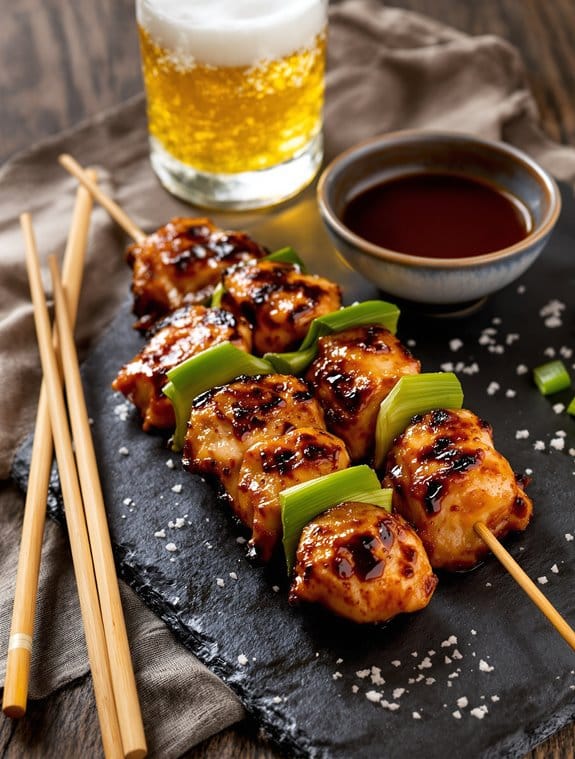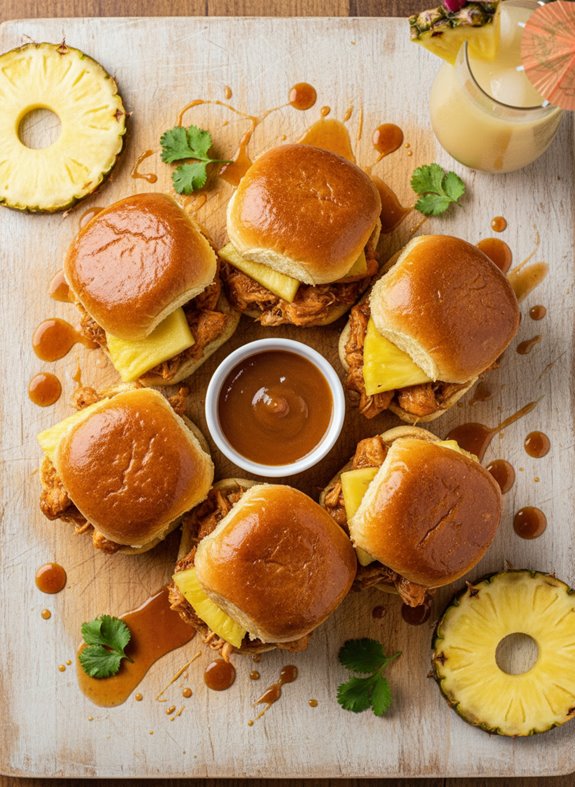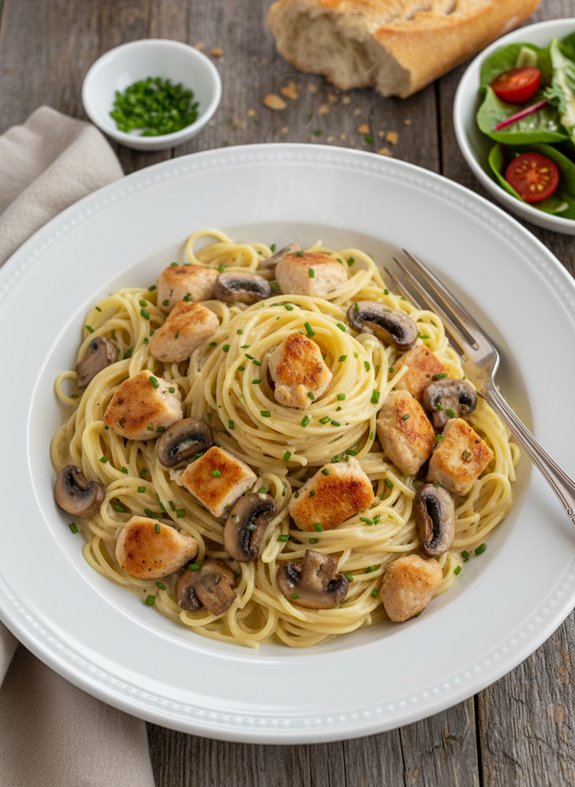Why You’ll Love this Authentic Japanese Yakitori
If you’ve never experienced the smoky, savory delight of authentic Japanese yakitori, you’re in for a treat.
This classic skewered chicken, glazed with a sweet-salty sauce that caramelizes beautifully on the grill, is truly worth mastering at home.
I love how the mirin and soy create that perfect umami balance, while the sugar adds just enough sweetness to make the edges crisp up nicely.
The beauty of yakitori? It’s deceptively simple yet deeply flavorful.
Plus, those juicy chicken thighs stay tender while the skin crisps up—a texture combination that’s absolutely mouthwatering.
Trust me, your backyard cookouts will never be the same.
What Ingredients are in Authentic Japanese Yakitori?
Traditional yakitori is all about simplicity and quality ingredients that come together to create those irresistible flavor-packed skewers. The heart of this dish lies in its tare sauce—that sweet-savory glaze that gives yakitori its signature taste. I’m always amazed at how just a handful of ingredients can create something so incredibly delicious when combined properly.
The sauce ingredients work together to create a perfect balance of salty, sweet, and umami flavors that coat every piece of chicken.
- 1 1/2 cups mirin
- 3/4 cup soy sauce
- 4 tablespoons sugar
- 1 garlic clove, pressed
- 1 pound boneless chicken thighs
- 1-2 green onions, cut into inch-long pieces
- 8 bamboo skewers
While the ingredient list is pretty straightforward, there are a few things worth noting about authentic yakitori.
The skin-on chicken thighs are traditional in Japan, as they add richness and that wonderful crispy texture when grilled. I recommend soaking those bamboo skewers in water for about 30 minutes before threading the chicken to prevent them from burning on the grill.
And don’t be tempted to substitute the mirin with another sweet wine—its distinctive flavor is essential for achieving that authentic yakitori taste that transports you straight to a bustling Tokyo yakitori shop.
How to Make this Authentic Japanese Yakitori

The magic of yakitori begins with preparing that irresistible sauce. In a medium-sized saucepan, combine 1½ cups mirin, ¾ cup soy sauce, 4 tablespoons sugar, and 1 pressed garlic clove. This mixture needs to simmer over medium heat until it reduces by half, concentrating all those flavors into a thick, glossy glaze. The reduction process usually takes about 15-20 minutes, and you’ll notice it becoming more syrupy as it cooks down. Let this sauce cool slightly while you prep the chicken—the aroma will have you counting the minutes until dinner.
While your sauce cools, prepare 1 pound of boneless chicken thighs by cutting them into bite-sized pieces. Traditional Japanese yakitori keeps the skin on for extra flavor and that wonderful crispy texture when grilled. Before threading the chicken onto your 8 bamboo skewers, soak those skewers in water for about 30 minutes to prevent burning—a step I learned the hard way after one too many charred skewer incidents.
Alternate the chicken pieces with 1-2 green onions cut into inch-long pieces for color, flavor, and that authentic look. Now comes the grilling technique that makes all the difference: start by grilling the chicken without any sauce until it begins changing color, usually about 2-3 minutes per side. Then, brush on that gorgeous tare sauce and continue grilling, turning the skewers and brushing with more sauce about three times total until the chicken is fully cooked and beautifully caramelized.
The multiple layers of sauce create that depth of flavor that makes yakitori so addictive. The key to truly authentic yakitori is in the timing of when you apply the sauce. Grilling the chicken first without sauce allows it to develop a nice sear that helps the meat hold onto more of that delicious glaze later. Each brushing of sauce builds another layer of flavor, and that final caramelization creates those irresistible charred bits that make you close your eyes with each bite.
I like to reserve a small portion of the sauce (before it touches raw chicken, of course) for a final brush right before serving. This way, you get that fresh, vibrant flavor alongside the deeper, caramelized notes from the grilling process. Serve your yakitori hot off the grill, perhaps with a cold beer or sake for the full Japanese izakaya experience.
Authentic Japanese Yakitori Substitutions and Variations
While authentic yakitori calls for specific ingredients, your kitchen pantry might tell a different story—and that’s perfectly okay!
No mirin? Try a mixture of sake (or dry white wine) with a touch of honey or sugar.
Chicken breast works in place of thighs, though you’ll miss that rich, juicy texture I adore.
Vegetarians can swap in firm tofu, mushrooms, or even eggplant chunks.
Beyond green onions, try bell peppers, zucchini, or cherry tomatoes between your chicken pieces.
For a spicy kick, add a dash of sriracha to your sauce.
Sometimes I even throw in a bit of ginger when I’m craving extra zing.
What to Serve with Authentic Japanese Yakitori
Now that you’ve mastered the skewers themselves, let’s talk about creating the complete yakitori experience on your plate.
I love serving yakitori with steamed white rice, which perfectly balances the savory-sweet glaze.
Add a simple cucumber salad with rice vinegar and sesame seeds for freshness, or try some pickled vegetables for that tangy contrast. A small bowl of miso soup makes the meal feel complete.
For drinks, nothing beats an ice-cold Japanese beer or sake at room temperature.
My friends always fight over the last skewer when I add shishito peppers or grilled eggplant to the spread. Total comfort food.
Final Thoughts
After mastering authentic yakitori at home, I’m convinced it’s one of the most rewarding Japanese dishes you can tackle in your own kitchen.
The sweet-savory glaze creates that irresistible caramelization that reminds me of Tokyo’s bustling yakitori stalls.
Don’t stress about perfection—even my first attempts were deliciously edible, if not Instagram-worthy.
The beauty of yakitori lies in its simplicity: quality chicken, a well-reduced sauce, and the magic of fire.

Japanese Yakitori
Ingredients
Equipment
Method
- In a medium-sized saucepan, combine mirin, soy sauce, sugar, and pressed garlic clove.
- Simmer the sauce mixture over medium heat until it reduces by half and becomes syrupy, about 15-20 minutes. Set aside to cool slightly.
- While the sauce cools, cut the chicken thighs into bite-sized pieces.
- Thread the chicken pieces onto the pre-soaked bamboo skewers, alternating with green onion pieces.
- Preheat your grill to medium-high heat.
- Grill the skewers without sauce first for about 2-3 minutes per side, until the chicken begins to change color.
- Brush the skewers with the tare sauce and continue grilling, turning and brushing with more sauce about three times total until the chicken is fully cooked and nicely caramelized.
- Reserve a small portion of the sauce (that hasn’t touched raw chicken) for a final brush right before serving.
- Serve hot off the grill.



